ECU MITSUBISHI 380 2005 Workshop Manual
[x] Cancel search | Manufacturer: MITSUBISHI, Model Year: 2005, Model line: 380, Model: MITSUBISHI 380 2005Pages: 1500, PDF Size: 47.87 MB
Page 341 of 1500

SYMPTOM PROCEDURES
SIMPLIFIED WIRING SYSTEM (SWS)54B-341
STEP 2. Check the input signal by using "FUNCTION
DIAG." menu of the SWS monitor.
Set each switch to the following condition before checking input
signal from the fog lamp switch:
Ignition switch: ON
Fog lamp switch: ON
NOTE: Turn the ignition switch to the "ON" position in order to
disable the headlamp automatic shutdown function.
To prevent damage to Diagnostic Tool MB991958, always
turn the ignition switch to the "LOCK" (OFF) position
before connecting or disconnecting Diagnostic Tool
MB991958. Connect special tool MB991910 before con-
necting special tool MB991812. Be sure to connect special
tool MB991806 after turning on special tool MB991824.
(1) Connect the special tool. Refer to "How to connect SWS
monitor P.54B-13."
(2) Operate Diagnostic Tool MB991958 according to the
procedure below to display "F.FOG."
a. Select "Interactive Diagnosis."
b. Select "System select."
c. Select "SWS."
d. Select "SWS MONITOR."
e. Select "Function Diag."
f. Select "LIGHTING."
g. Select "F.FOG."
(3) Check that normal conditions are displayed for the items
described in the table below.
Q: Does the Diagnostic Tool MB991958 display the items
"IG SW (IG1)" and "F.FOG LAMP" as normal condition?
Normal conditions are displayed for all the items : Go to
St e p 3 .
Normal condition is not displayed for "IG SW (IG1)" :
Refer to Inspection Procedure M-2 "ETACS-ECU
does not receive any signal from the ignition switch
(IG1) P.54B-408."
Normal condition is not displayed for "F.FOG LAMP" :
Refer to Inspection Procedure M-3 "ETACS-ECU
does not receive any signal from the fog lamp switch
P.54B-410." ITEM NO. ITEM NAME NORMAL CONDITION
ITEM 30 IG SW (IG1) ON
ITEM 36 F.FOG LAMP ON
Page 344 of 1500
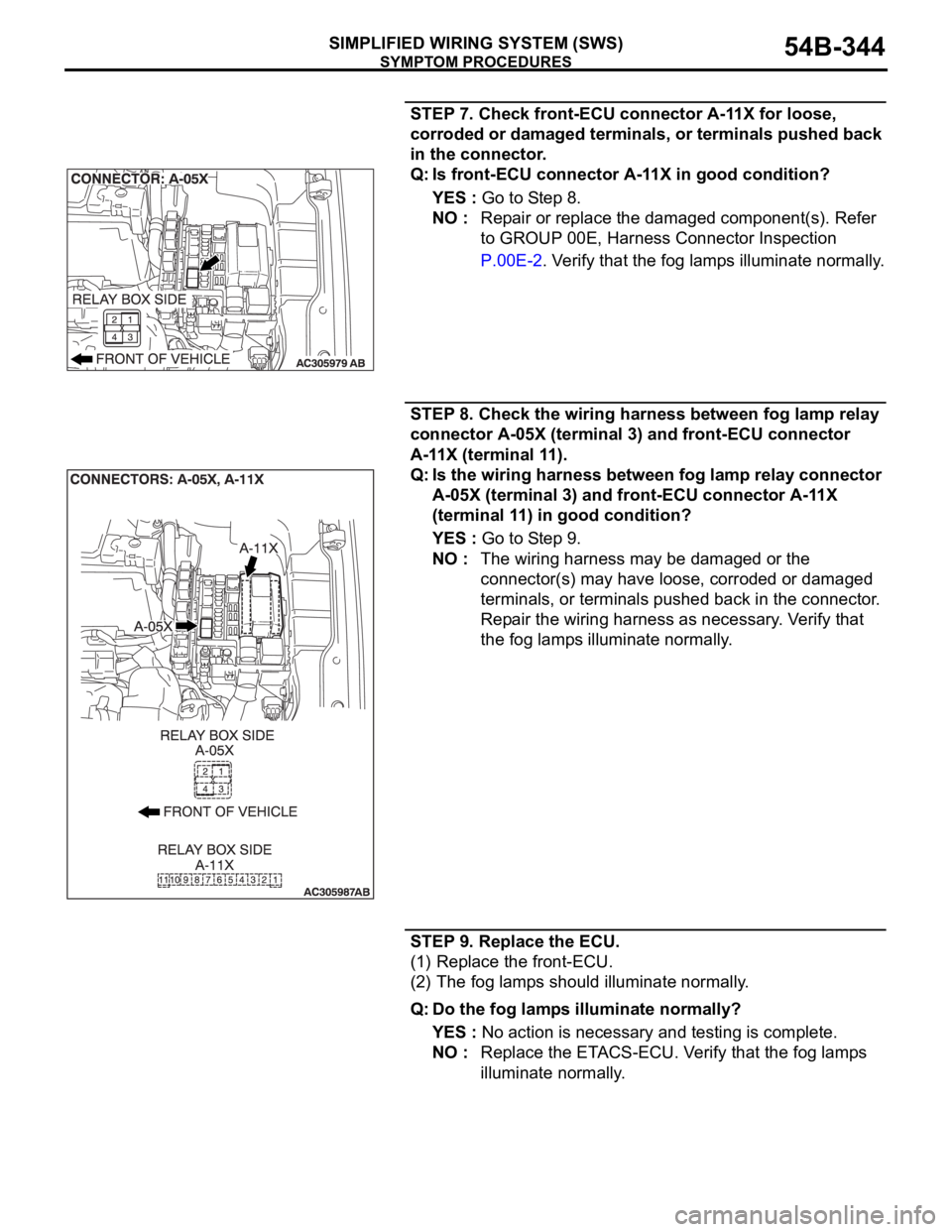
SYMPTOM PROCEDURES
SIMPLIFIED WIRING SYSTEM (SWS)54B-344
STEP 7. Check front-ECU connector A-11X for loose,
corroded or damaged terminals, or terminals pushed back
in the connector.
Q: Is front-ECU connector A-11X in good condition?
YES : Go to Step 8.
NO : Repair or replace the damaged component(s). Refer
to GROUP 00E, Harness Connector Inspection
P.00E-2. Verify that the fog lamps illuminate normally.
STEP 8. Check the wiring harness between fog lamp relay
connector A-05X (terminal 3) and front-ECU connector
A-11X (terminal 11).
Q: Is the wiring harness between fog lamp relay connector
A-05X (terminal 3) and front-ECU connector A-11X
(terminal 11) in good condition?
YES : Go to Step 9.
NO : The wiring harness may be damaged or the
connector(s) may have loose, corroded or damaged
terminals, or terminals pushed back in the connector.
Repair the wiring harness as necessary. Verify that
the fog lamps illuminate normally.
STEP 9. Replace the ECU.
(1) Replace the front-ECU.
(2) The fog lamps should illuminate normally.
Q: Do the fog lamps illuminate normally?
YES : No action is necessary and testing is complete.
NO : Replace the ETACS-ECU. Verify that the fog lamps
illuminate normally.
Page 345 of 1500
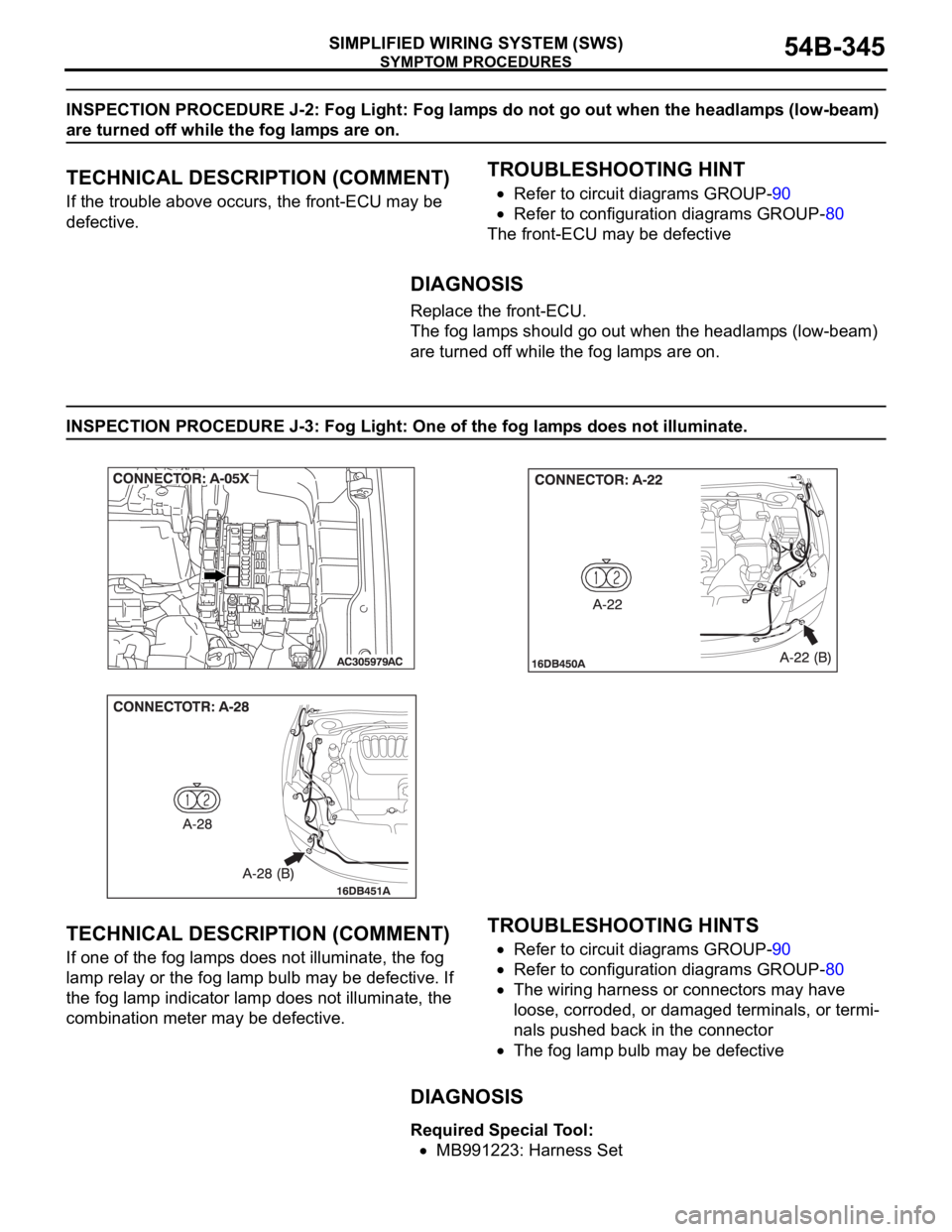
SYMPTOM PROCEDURES
SIMPLIFIED WIRING SYSTEM (SWS)54B-345
INSPECTION PROCEDURE J-2: Fog Light: Fog lamps do not go out when the headlamps (low-beam)
are turned off while the fog lamps are on.
.
TECHNICAL DESCRIPTION (COMMENT)
If the trouble above occurs, the front-ECU may be
defective.
.
TROUBLESHOOTING HINT
Refer to circuit diagrams GROUP-90
Refer to configuration diagrams GROUP-80
The front-ECU may be defective
DIAGNOSIS
Replace the front-ECU.
The fog lamps should go out when the headlamps (low-beam)
are turned off while the fog lamps are on.
INSPECTION PROCEDURE J-3: Fog Light: One of the fog lamps does not illuminate.
.
TECHNICAL DESCRIPTION (COMMENT)
If one of the fog lamps does not illuminate, the fog
lamp relay or the fog lamp bulb may be defective. If
the fog lamp indicator lamp does not illuminate, the
combination meter may be defective.
.
TROUBLESHOOTING HINTS
Refer to circuit diagrams GROUP-90
Refer to configuration diagrams GROUP-80
The wiring harness or connectors may have
loose, corroded, or damaged terminals, or termi-
nals pushed back in the connector
The fog lamp bulb may be defective
.
DIAGNOSIS
Required Special Tool:
MB991223: Harness Set
Page 351 of 1500

SYMPTOM PROCEDURES
SIMPLIFIED WIRING SYSTEM (SWS)54B-351
CIRCUIT OPERATION
At the same time that the fog lamps are illuminated,
the ETACS-ECU sends a signal to illuminate the fog
lamp indicator via the CAN bus line.
.
TECHNICAL DESCRIPTION (COMMENT)
If the fog lamp indicator does not illuminate normally,
connector(s), wiring harness in the CAN bus lines,
the ETACS-ECU or the combination meter may be
defective.
.
TROUBLESHOOTING HINTS
Refer to circuit diagrams GROUP-90
Refer to configuration diagrams GROUP-80
Trouble in input signal system
The wiring harness or connectors may have
loose, corroded, or damaged terminals, or termi-
nals pushed back in the connector
The combination meter may be defective
The ETACS-ECU may be defective
.
Page 352 of 1500
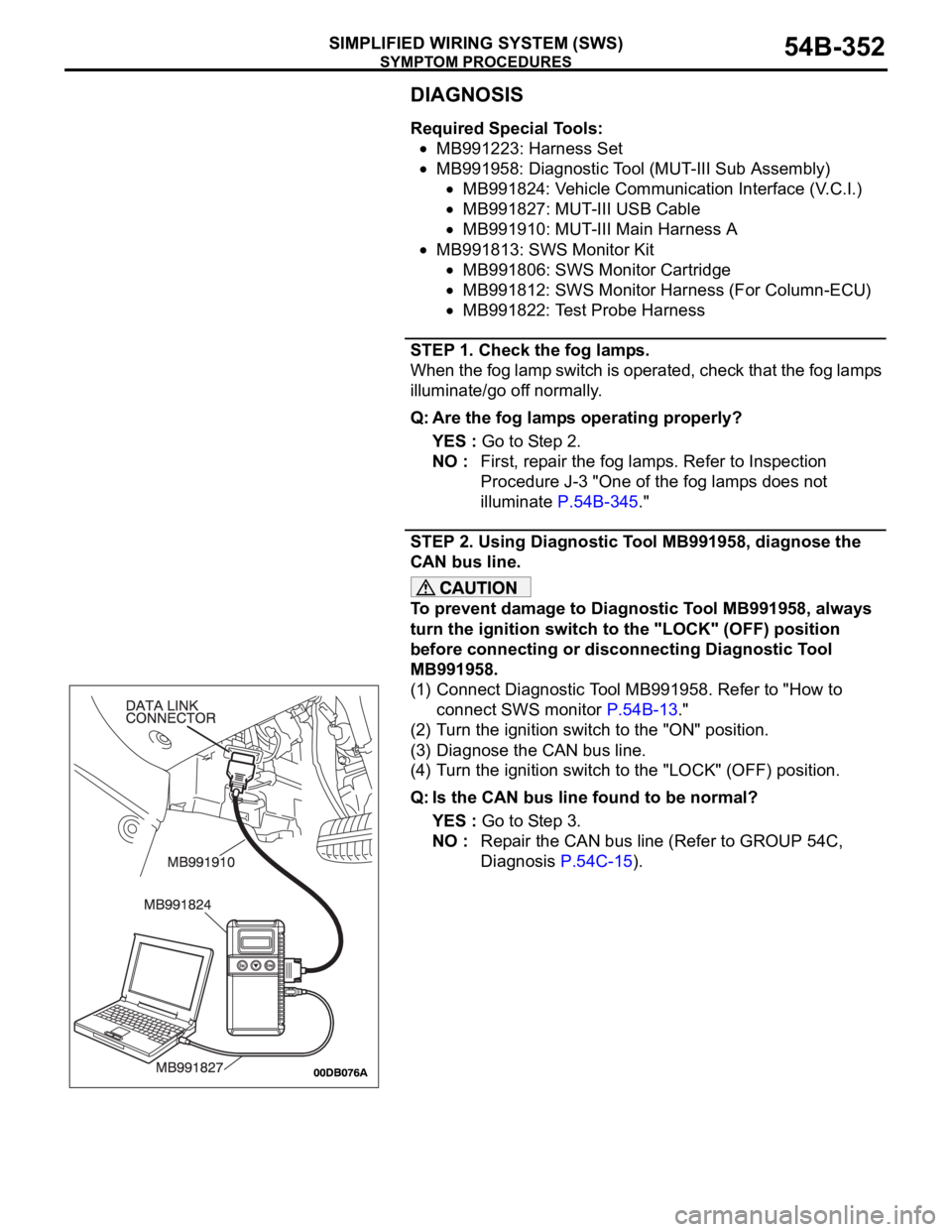
SYMPTOM PROCEDURES
SIMPLIFIED WIRING SYSTEM (SWS)54B-352
DIAGNOSIS
Required Special Tools:
MB991223: Harness Set
MB991958: Diagnostic Tool (MUT-III Sub Assembly)
MB991824: Vehicle Communication Interface (V.C.I.)
MB991827: MUT-III USB Cable
MB991910: MUT-III Main Harness A
MB991813: SWS Monitor Kit
MB991806: SWS Monitor Cartridge
MB991812: SWS Monitor Harness (For Column-ECU)
MB991822: Test Probe Harness
STEP 1. Check the fog lamps.
When the fog lamp switch is operated, check that the fog lamps
illuminate/go off normally.
Q: Are the fog lamps operating properly?
YES : Go to Step 2.
NO : First, repair the fog lamps. Refer to Inspection
Procedure J-3 "One of the fog lamps does not
illuminate P.54B-345."
STEP 2. Using Diagnostic Tool MB991958, diagnose the
CAN bus line.
To prevent damage to Diagnostic Tool MB991958, always
turn the ignition switch to the "LOCK" (OFF) position
before connecting or disconnecting Diagnostic Tool
MB991958.
(1) Connect Diagnostic Tool MB991958. Refer to "How to
connect SWS monitor P.54B-13."
(2) Turn the ignition switch to the "ON" position.
(3) Diagnose the CAN bus line.
(4) Turn the ignition switch to the "LOCK" (OFF) position.
Q: Is the CAN bus line found to be normal?
YES : Go to Step 3.
NO : Repair the CAN bus line (Refer to GROUP 54C,
Diagnosis P.54C-15).
Page 354 of 1500
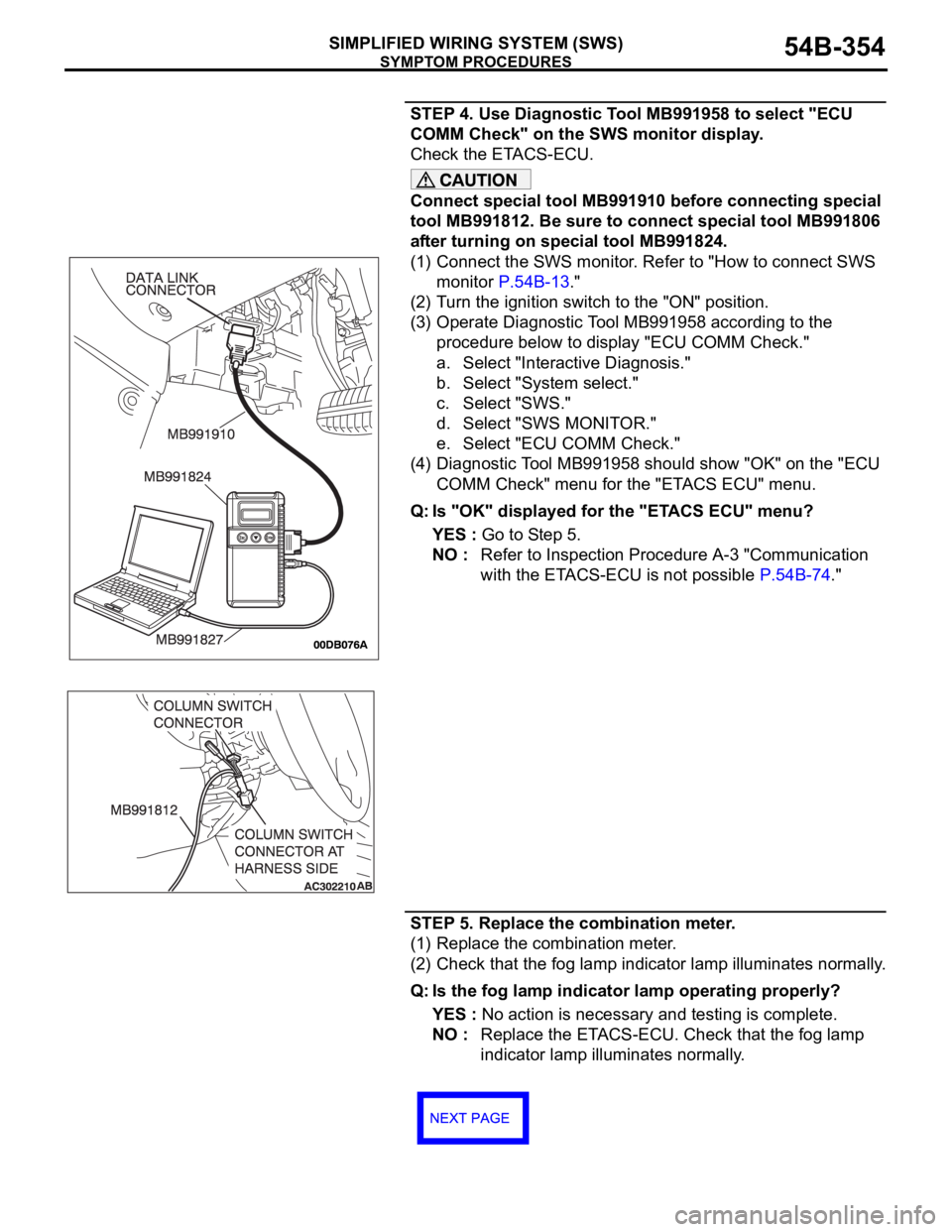
SYMPTOM PROCEDURES
SIMPLIFIED WIRING SYSTEM (SWS)54B-354
STEP 4. Use Diagnostic Tool MB991958 to select "ECU
COMM Check" on the SWS monitor display.
Check the ETACS-ECU.
Connect special tool MB991910 before connecting special
tool MB991812. Be sure to connect special tool MB991806
after turning on special tool MB991824.
(1) Connect the SWS monitor. Refer to "How to connect SWS
monitor P.54B-13."
(2) Turn the ignition switch to the "ON" position.
(3) Operate Diagnostic Tool MB991958 according to the
procedure below to display "ECU COMM Check."
a. Select "Interactive Diagnosis."
b. Select "System select."
c. Select "SWS."
d. Select "SWS MONITOR."
e. Select "ECU COMM Check."
(4) Diagnostic Tool MB991958 should show "OK" on the "ECU
COMM Check" menu for the "ETACS ECU" menu.
Q: Is "OK" displayed for the "ETACS ECU" menu?
YES : Go to Step 5.
NO : Refer to Inspection Procedure A-3 "Communication
with the ETACS-ECU is not possible P.54B-74."
STEP 5. Replace the combination meter.
(1) Replace the combination meter.
(2) Check that the fog lamp indicator lamp illuminates normally.
Q: Is the fog lamp indicator lamp operating properly?
YES : No action is necessary and testing is complete.
NO : Replace the ETACS-ECU. Check that the fog lamp
indicator lamp illuminates normally.
Page 355 of 1500
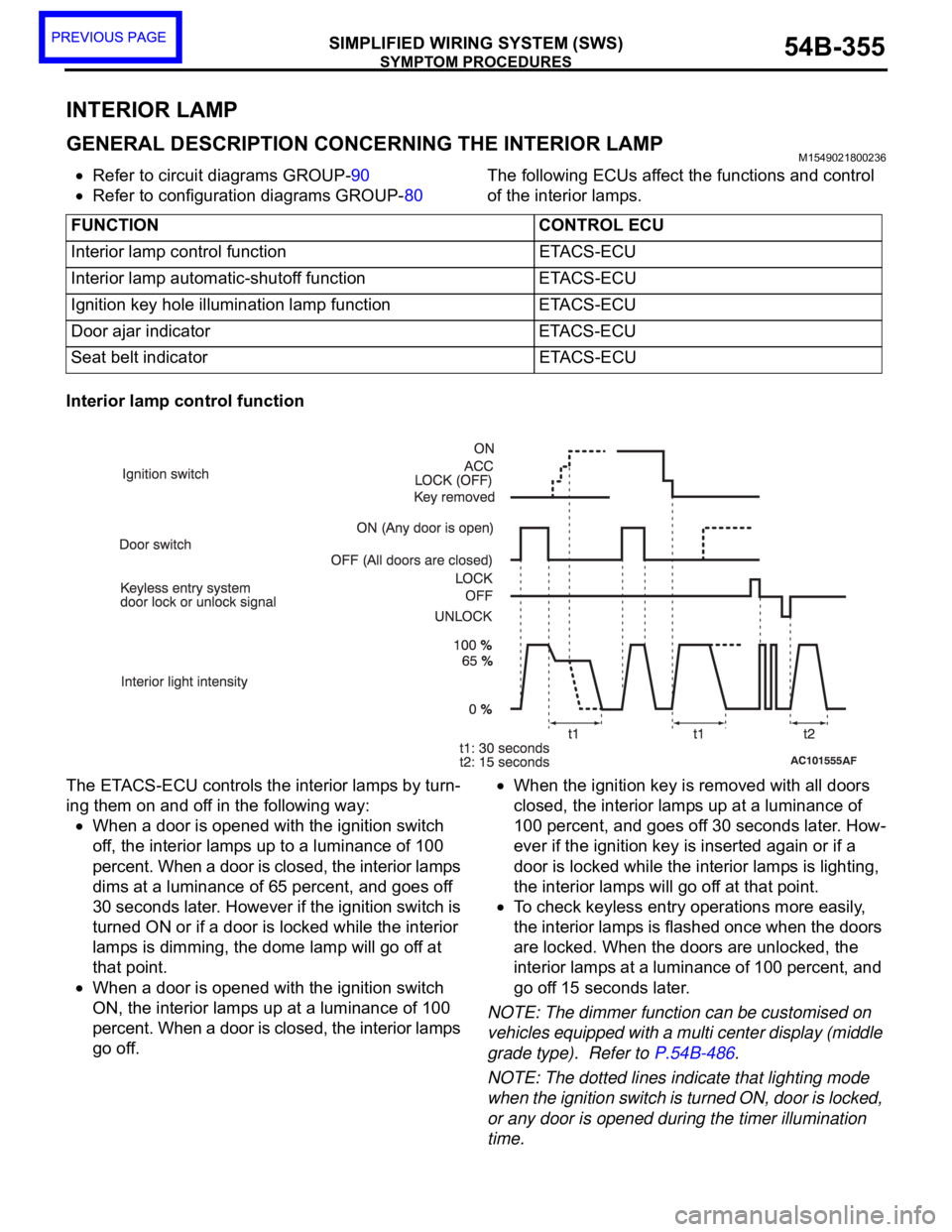
SYMPTOM PROCEDURES
SIMPLIFIED WIRING SYSTEM (SWS)54B-355
54B
INTERIOR LAMP
GENERAL DESCRIPTION CONCERNING THE INTERIOR LAMPM1549021800236
Refer to circuit diagrams GROUP-90
Refer to configuration diagrams GROUP-80The following ECUs affect the functions and control
of the interior lamps.
Interior lamp control function
The ETACS-ECU controls the interior lamps by turn-
ing them on and off in the following way:
When a door is opened with the ignition switch
off, the interior lamps up to a luminance of 100
percent. When a door is closed, the interior lamps
dims at a luminance of 65 percent, and goes off
30 seconds later. However if the ignition switch is
turned ON or if a door is locked while the interior
lamps is dimming, the dome lamp will go off at
that point.
When a door is opened with the ignition switch
ON, the interior lamps up at a luminance of 100
percent. When a door is closed, the interior lamps
go off.
When the ignition key is removed with all doors
closed, the interior lamps up at a luminance of
100 percent, and goes off 30 seconds later. How-
ever if the ignition key is inserted again or if a
door is locked while the interior lamps is lighting,
the interior lamps will go off at that point.
To check keyless entry operations more easily,
the interior lamps is flashed once when the doors
are locked. When the doors are unlocked, the
interior lamps at a luminance of 100 percent, and
go off 15 seconds later.
NOTE: The dimmer function can be customised on
vehicles equipped with a multi center display (middle
grade type). Refer to P.54B-486.
NOTE: The dotted lines indicate that lighting mode
when the ignition switch is turned ON, door is locked,
or any door is opened during the timer illumination
time. FUNCTION CONTROL ECU
Interior lamp control function ETACS-ECU
Interior lamp automatic-shutoff function ETACS-ECU
Ignition key hole illumination lamp function ETACS-ECU
Door ajar indicator ETACS-ECU
Seat belt indicator ETACS-ECU
Page 356 of 1500
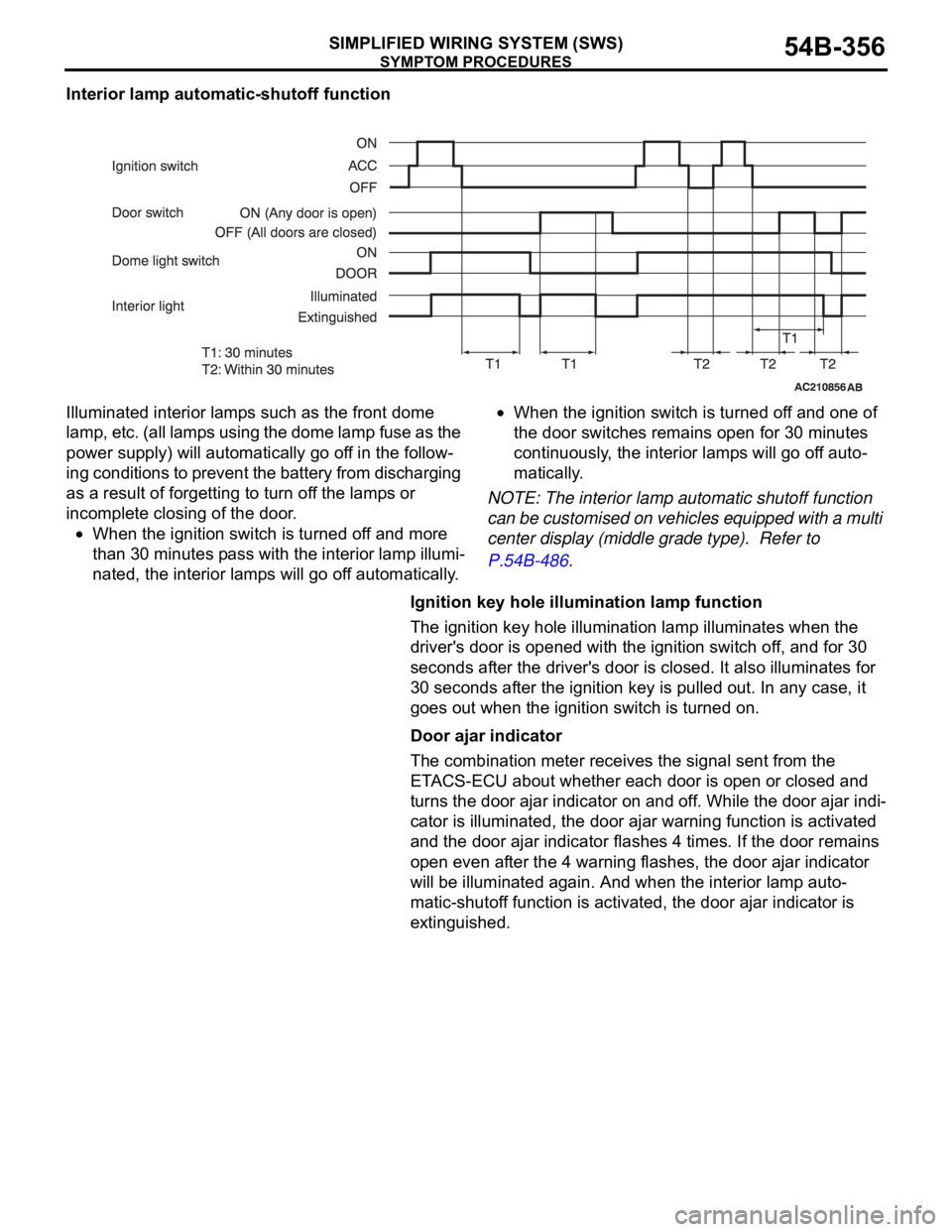
SYMPTOM PROCEDURES
SIMPLIFIED WIRING SYSTEM (SWS)54B-356
Interior lamp automatic-shutoff function
Illuminated interior lamps such as the front dome
lamp, etc. (all lamps using the dome lamp fuse as the
power supply) will automatically go off in the follow-
ing conditions to prevent the battery from discharging
as a result of forgetting to turn off the lamps or
incomplete closing of the door.
When the ignition switch is turned off and more
than 30 minutes pass with the interior lamp illumi-
nated, the interior lamps will go off automatically.
When the ignition switch is turned off and one of
the door switches remains open for 30 minutes
continuously, the interior lamps will go off auto-
matically.
NOTE: The interior lamp automatic shutoff function
can be customised on vehicles equipped with a multi
center display (middle grade type). Refer to
P.54B-486.
Ignition key hole illumination lamp function
The ignition key hole illumination lamp illuminates when the
driver's door is opened with the ignition switch off, and for 30
seconds after the driver's door is closed. It also illuminates for
30 seconds after the ignition key is pulled out. In any case, it
goes out when the ignition switch is turned on.
Door ajar indicator
The combination meter receives the signal sent from the
ETACS-ECU about whether each door is open or closed and
turns the door ajar indicator on and off. While the door ajar indi-
cator is illuminated, the door ajar warning function is activated
and the door ajar indicator flashes 4 times. If the door remains
open even after the 4 warning flashes, the door ajar indicator
will be illuminated again. And when the interior lamp auto-
matic-shutoff function is activated, the door ajar indicator is
extinguished.
Page 358 of 1500

SYMPTOM PROCEDURES
SIMPLIFIED WIRING SYSTEM (SWS)54B-358
If any of the following conditions is met with the igni-
tion switch at "ON" or "ST", the ETACS-ECU illumi-
nates, flashes or extinguishes the seat belt indicator
by using the driver's seat belt switch signal and the
vehicle speed signal sent from the combination
meter.
Illuminates when the ignition switch is at "ON"
and the seat belt switch is turned on (the driver's
seat belt is unfastened).
Flashes and illuminates the indicator 12 cycles
(after 0.5 seconds) if any of the following condi-
tions is met when sixty seconds or more have
elapsed since the ignition switch is turned "ON".
One cycle consists of five-second "flashing" and
then three-second "illumination".a. The vehicle speed has reached 8 km/h (5
mph) while the seat belt switch is turned on
(driver's seat belt is not fastened) with the
ignition switch "ON.
b. The seat belt switch has been turned on
(driver's seat belt has not been fastened) for
at least ten seconds while the ignition switch
has been turned "ON" and the vehicle speed
has been 8 km/h (5 mph) or more.
NOTE: Once this timer operation has been acti-
vated, it will not be activated again until the
vehicle speed reduces to 3 km/h (2 mph) or
less even if any of the following conditions is
met.
The indicator stops illuminating if the ignition
switch or the seat belt switch is turned off (the
driver's seat belt is fastened) while the timer
operation is active.
Page 359 of 1500
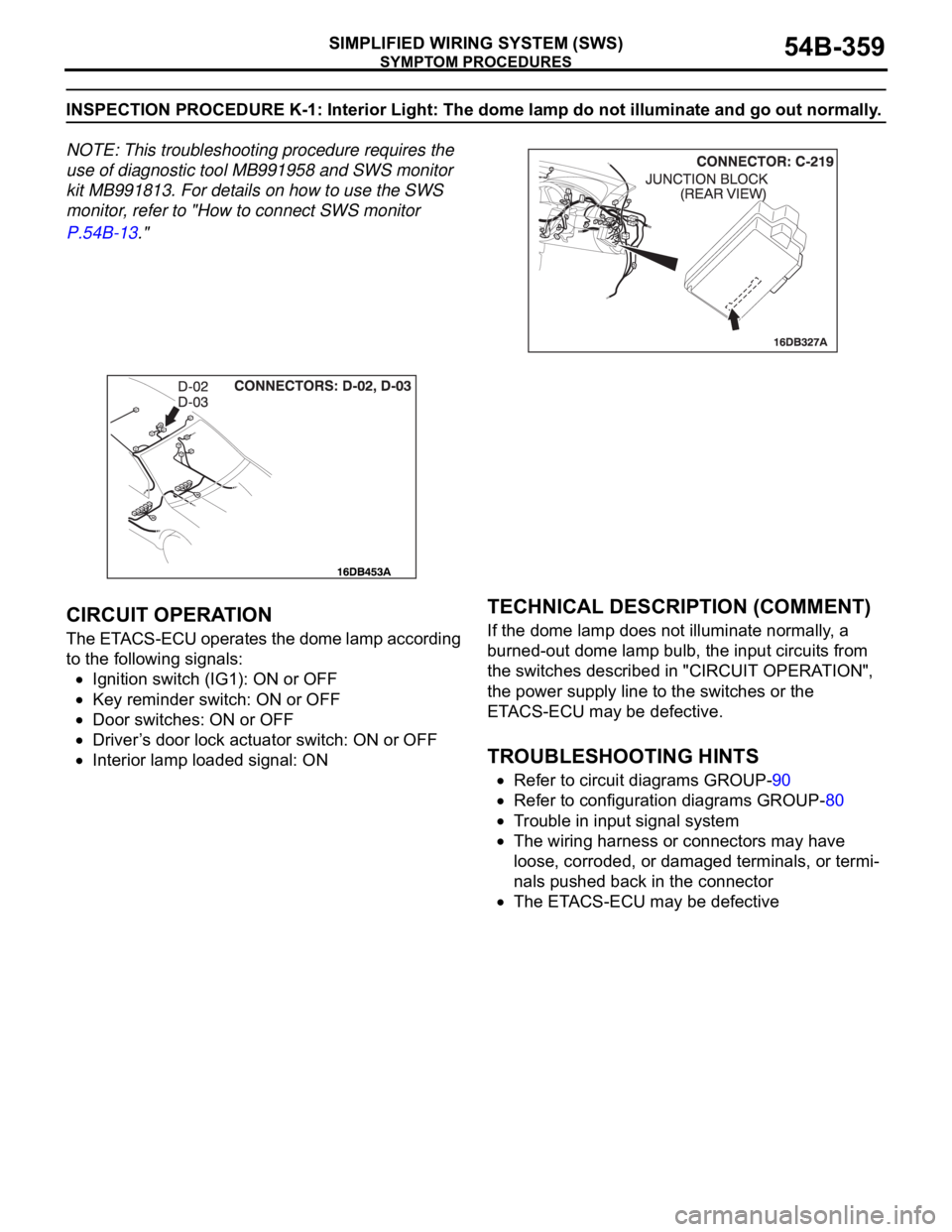
SYMPTOM PROCEDURES
SIMPLIFIED WIRING SYSTEM (SWS)54B-359
INSPECTION PROCEDURE K-1: Interior Light: The dome lamp do not illuminate and go out normally.
NOTE: This troubleshooting procedure requires the
use of diagnostic tool MB991958 and SWS monitor
kit MB991813. For details on how to use the SWS
monitor, refer to "How to connect SWS monitor
P.54B-13."
.
CIRCUIT OPERATION
The ETACS-ECU operates the dome lamp according
to the following signals:
Ignition switch (IG1): ON or OFF
Key reminder switch: ON or OFF
Door switches: ON or OFF
Driver’s door lock actuator switch: ON or OFF
Interior lamp loaded signal: ON
.
TECHNICAL DESCRIPTION (COMMENT)
If the dome lamp does not illuminate normally, a
burned-out dome lamp bulb, the input circuits from
the switches described in "CIRCUIT OPERATION",
the power supply line to the switches or the
ETACS-ECU may be defective.
.
TROUBLESHOOTING HINTS
Refer to circuit diagrams GROUP-90
Refer to configuration diagrams GROUP-80
Trouble in input signal system
The wiring harness or connectors may have
loose, corroded, or damaged terminals, or termi-
nals pushed back in the connector
The ETACS-ECU may be defective